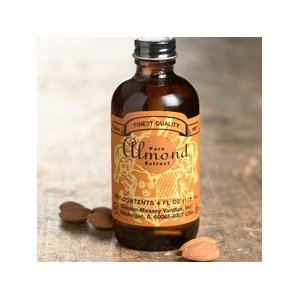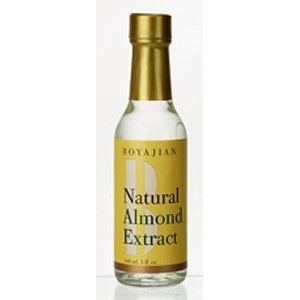Why did my dye smell like almonds or marzipan?
Name: Ann
—ADVERTISEMENTS—
Waring and Hallas's

The Chemistry and Application of Dyes (Topics in Applied Chemistry)
includes recipes for synthesizing Procion MX and other dyes
World Health Organization's

Nitrobenzene (Environmental Health Criteria Series)
Nitrobenzene is a colourless to pale yellow oily liquid with an odour resembling that of bitter almonds or shoe polish. This book evaluates the risks to human health and the environment posed by nitrobenzene.
Pure Almond Extract

"Pure" almond extract contains benzaldehyde from bitter almonds.
Natural Almond Extract

"Natural" almond extract contains benzaldehyde made from a different plant, the cassia.
Country or region: Canada
Message: No big crisis or anything but I was making up some ProChem turquoise dye and it smells like almonds or marzipan. I just wondered if you knew why.
It's an interesting question. I've never noticed this particular odor with Procion Turquoise MX-G, but I did notice it when opening a jar containing Procion Blue MX-7RX, which I ordered a few years ago from Germany. Another jar of the same dye that I ordered from a different company lacked the almond odor. Normally the only odor I notice with the Procion dyes, trying, as we all do, not to breathe any at all, is a chlorine smell that I associate with the chlorine atom on the reactive part of the dye molecule. (The chlorine atoms in Procion MX dyes are so important to the dye reaction that they're mentioned in the name for this entire class of dyes, the dichlorotriazines.)
There are surprisingly many chemicals that smell like almonds, although their structures can be quite different from one another. Almond-scented chemicals include deadly hydrogen cyanide as well as nitrobenzene, benzaldehyde, benzonitrile, and trans-2-hexenal. Look at how different their chemical structures are from one another (keeping in mind that there is a carbon atom wherever two lines meet at an angle, and most hydrogen atoms are not shown at all):
Trans-2-hexenal:
There are surprisingly many chemicals that smell like almonds, although their structures can be quite different from one another. Almond-scented chemicals include deadly hydrogen cyanide as well as nitrobenzene, benzaldehyde, benzonitrile, and trans-2-hexenal. Look at how different their chemical structures are from one another (keeping in mind that there is a carbon atom wherever two lines meet at an angle, and most hydrogen atoms are not shown at all):
Trans-2-hexenal:
Benzonitrile:

Benzaldehyde:

As reported in Wikipedia, "Benzaldehyde is used chiefly as a precursor to other organic compounds, ranging from pharmaceuticals to plastic additives. The aniline dye malachite green is prepared from benzaldehyde and dimethylaniline. It is a precursor to certain acridine dyes as well." It is a common food additive, and is naturally responsible for the almond flavor of foods such as marzipan.
Hydrogen cyanide:
Hydrogen cyanide is a deadly poison, too toxic to have been the source of the odor you noticed, especially since its almond odor is described as being faint. Coincidentally, as reported in Wikipedia, hydrogen cyanide was first isolated from a blue dye, Prussian blue, which is hydrated ferric ferrocyanide. (We can be sure that there's no Prussian blue in our Procion dyes.) In another coincidence, cyanuric chloride, which is prepared from hydrogen cyanide, is the chemical precursor for the reactive section of Procion MX dye molecules, but its odor is described as pungent, not resembling almonds.
Nitrobenzene:

Nitrobenzene:

As described in Wikipedia, nitrobenzene is occasionally used in the laboratory as a solvent, especially for electrophilic reagents.
This last one is of particular interest to this question. Nitrobenzene is listed in Wikipedia as a "related compound" to Benzenediazonium chloride—a key intermediate in the synthesis of azo dyes, including the colored section of the Procion dye molecule. Here's the structure of benzenediazonium chloride:

Numerous chemical producer web sites describe nitrobenzene as a dye intermediate.
I don't know for sure whether the almond odor you observed is due to the presence of a small amount of contamination with nitrobenzene, but it seems to me to be the most likely alternative. Benzaldehyde is also possible, but seems less likely to be a contaminant in the copper phthalocyanine dye in which you observed the odor.
Nitrobenzene was once used as a food additive, for the purpose of providing almond flavor, but it is now considered to be far too toxic for that use. Excessive exposure can cause a serious medical condition, methemoglobinemia. According to an MSDS provided by JT Baker, the lethal dose, if nitrobenzene is swallowed, is one to five grams (between less than a quarter teaspoon and less than one teaspoon of pure liquid nitrobenzene). I doubt that the exposure involved in occasionally catching a slight whiff of it is significant, but someone who works all day at measuring out dyes would need to take safety precautions against breathing all possible contaminants, especially including good ventilation.
(Please help support this web site. Thank you.)
This last one is of particular interest to this question. Nitrobenzene is listed in Wikipedia as a "related compound" to Benzenediazonium chloride—a key intermediate in the synthesis of azo dyes, including the colored section of the Procion dye molecule. Here's the structure of benzenediazonium chloride:

Numerous chemical producer web sites describe nitrobenzene as a dye intermediate.
I don't know for sure whether the almond odor you observed is due to the presence of a small amount of contamination with nitrobenzene, but it seems to me to be the most likely alternative. Benzaldehyde is also possible, but seems less likely to be a contaminant in the copper phthalocyanine dye in which you observed the odor.
Nitrobenzene was once used as a food additive, for the purpose of providing almond flavor, but it is now considered to be far too toxic for that use. Excessive exposure can cause a serious medical condition, methemoglobinemia. According to an MSDS provided by JT Baker, the lethal dose, if nitrobenzene is swallowed, is one to five grams (between less than a quarter teaspoon and less than one teaspoon of pure liquid nitrobenzene). I doubt that the exposure involved in occasionally catching a slight whiff of it is significant, but someone who works all day at measuring out dyes would need to take safety precautions against breathing all possible contaminants, especially including good ventilation.
(Please help support this web site. Thank you.)
Posted: Wednesday - May 04, 2011 at 06:21 AM
Follow this blog on twitter here.
Quick Links
- All About Dyes & Dyeing Top -
- Top of this blog -
- FAQ -
- The Dye Forum -
- How to Tie Dye - How to Batik -
- Books - Toys - Plants -
- Top of this blog -
- FAQ -
- The Dye Forum -
- How to Tie Dye - How to Batik -
- Books - Toys - Plants -
More in this category:
- -
Statistics
Total entries in this blog:
Total entries in this category:
Published On: Aug 29, 2012 02:49 PM
Total entries in this category:
Published On: Aug 29, 2012 02:49 PM